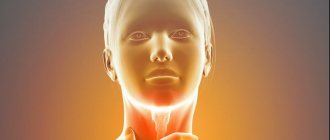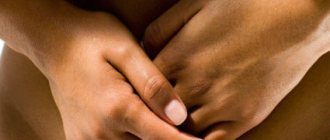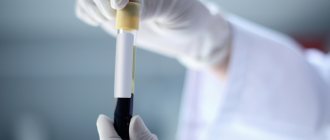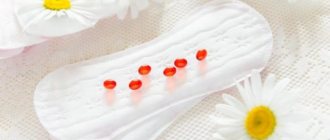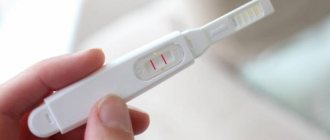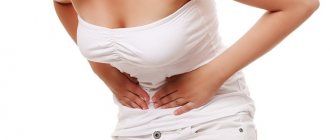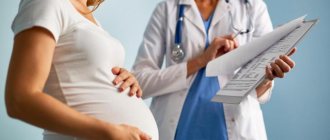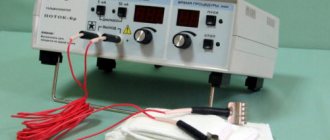Can the ovary hurt before and during ovulation?
To understand why pain occurs in the ovaries during ovulation, it is necessary to pay attention to the physiological processes occurring in the female body.
During the follicular phase, which occurs at the beginning of the cycle, the female cell grows and matures. This period continues until the middle of the cycle. Sometimes the ovary may pull before ovulation. This occurs due to the accumulation and increase of fluid in the vesicles where oocytes (eggs) mature, which creates pressure on the walls of the ovary and nearby organs. Such follicles can reach 2 cm in diameter. When performing an ultrasound, you can notice how the ovary enlarges on one side, where the dominant follicle is located.
When the end of follicle maturation is reached, a sharp rise in the hormone estrogen occurs in the body, which is responsible for increasing the concentration of follicle-stimulating and luteinizing hormones.
This continues for about a day, after which the follicle ruptures, releasing the oocyte with fluid into the abdominal cavity. Hormones help to weaken and soften the tissue of the follicle so that it is easier for the egg to escape from its “dungeon.” Most ladies do not feel anything, but some feel discomfort. This can be expressed not only by pain in the side, but also by migraine.
https://www.youtube.com/watch?v=avWUfRMeYQY After ovulation, a corpus luteum forms in the ovary in place of the oocyte, increasing in size. It reaches its largest size 7–8 days after ovulation, which also creates tension inside the organ and can cause pain. The corpus luteum resides in the ovary for two weeks, but more often a woman may feel discomfort only the first day, in rare cases - a week after ovulation.
Attention! A long-term painful condition of the ovaries indicates problems in the female reproductive organs. This condition cannot be ignored; you must see a doctor.
Causes of pain in the ovaries associated with the phases of the menstrual cycle
When using incorrectly selected hormonal drugs, ovarian hyperstimulation syndrome may develop. Blood pressure may drop, discomfort or severe pain may appear. Treatment requires adjustment of hormonal medications.
Adnexit
Pain requires treatment if the cause is adnexitis. Adnexitis (salpingoophoritis) – inflammation of the appendages. More often it manifests itself in an acute or chronic form. During this period, adhesions form on the pipes. With adnexitis, in addition to pain, a high temperature may be observed, and discharge with a purulent mass from the vagina itself is also possible.
Polycystic
With polycystic disease, a large number of growths form around the ovary. This interferes with the release of the egg. Symptoms of polycystic disease:
- failure and change in the menstrual cycle;
- hormonal disbalance;
- increase in hair growth, like in men;
- pain in the right or left ovary.
Polycystic disease requires mandatory treatment, otherwise it can lead to irreversible infertility.
Apoplexy
Apoplexy is rupture of the ovary. Hemorrhage occurs in the abdominal cavity. The right side is more likely to rupture. Remember, sharp, very strong, sharp, stabbing pain in the ovary is a very important symptom, indicating the need for urgent surgical intervention.
A very common occurrence is ovulatory syndrome. Pain in the ovarian area in women after ovulation can be caused by partial detachment of the uterine mucosa due to impaired hormone levels. During ovulation, discomfort may also occur. They are a normal phenomenon, except for the situation when the pain is acute and lasts more than a day, there is an increase in body temperature.
It is not recommended to treat diseases of this group on your own. After determining the diagnosis, the doctor will prescribe the necessary medications. Very often, antibiotics and anti-inflammatory drugs are needed for treatment.
The symptoms of all diseases associated with the appearance of pain in the ovaries in women are similar to each other, so you should immediately visit a doctor, otherwise there may be consequences, including infertility and even death.
Throughout the entire menstrual cycle, a woman’s reproductive organs and hormone levels change. Likewise, the ovaries are constantly undergoing changes.
During ovulation
Some women do not feel signs of ovulation. Others, on the contrary, say that the pain in the ovarian region during this period acquires a stabbing, pulling character. Brief discomfort does not pose a threat to the body and does not require any treatment. This is due to the rupture of the follicle, which releases a mature egg for conception.
Also, during ovulation, the ovary may prick due to exacerbation of inflammatory processes in the pelvic organs (adnexitis, oophoritis). At the same time, after training, stress, or lifting weights, unusual discharge is observed. To reduce pain and relieve discomfort in the lower abdomen, a woman is recommended to take analgesics (Spazmalgon, No-Shpa).
If after taking a painkiller the ovaries still hurt, then the reason is not ovulation. The patient needs to consult a doctor, be examined, and begin appropriate treatment. Remember! Each woman experiences ovarian pain differently. It all depends on age, chronic diseases, pain threshold and other individual characteristics of the body.
During your period
It is considered normal if pain in the ovaries appears a few days before the start of menstruation and becomes stronger during it. On the first day, women feel mild nausea and dizziness. The nature of the pain is twisting, stabbing, aching. There are cases when, towards the end of menstruation, a woman begins to vomit.
Lifting weights, overwork, disturbances in the psycho-emotional state, and constant stressful situations lead to an increase in pain and a worsening of a woman’s general well-being. What can be done in this situation and how to reduce the pain? No treatment is required for painful periods. A woman just needs to take a painkiller (for example, Tamipul) or apply a warm heating pad to her lower abdomen.
During menopause
Menopause is accompanied by a series of hormonal changes in the body due to the lack of bleeding. She appears individually. Menopause occurs at the age of 45-50 years. The onset of menopause can provoke pain in the ovaries, but such pain does not last long. During this period, a woman is more susceptible to infections and viruses.
The following are the causes of pain in the ovaries after menopause:
- inflammation;
- cyst;
- malignant tumors.
Pain in the ovaries is accompanied by changes in vaginal tissue, frequent urination, sweating, impaired bowel movements, and increased body temperature. Therapy depends on the nature of the complaints and the identified cause of discomfort.
As mentioned earlier, if pain in the ovaries lasts more than two to three days, and discharge of an uncharacteristic color and odor appears, this indicates a disease of the pelvic organs. Most often it is inflammation, cystic neoplasm, cancer, miscarriage or ectopic pregnancy. Let's look at each reason in more detail.
Inflammation of the ovaries
Inflammation may be accompanied by severe pain in the lower abdomen and fever. It can be unilateral (affects one appendage) or bilateral (occurs on two ovaries at once). In acute inflammation, the following symptoms appear:
- sudden severe pain in the ovarian area;
- fever;
- chills;
- purulent vaginal discharge;
- abdominal cramps;
- constipation;
- nausea.
Due to lack of treatment and resulting scarring, symptoms may persist for years, even after healing. If there is a sharp stabbing in the lower abdomen, then the ovary is inflamed. The occurrence of infection of the appendage is influenced by:
- frequent change of sexual partners;
- vaginal contraceptives (spiral);
- smoking;
- regular vaginal douching;
- curettage, abortion.
Treatment of pelvic inflammatory diseases occurs with the help of oral antibiotics and vaginal suppositories. Therapy depends on the nature and severity of the pathology. If the ovaries are very painful, the symptoms are pronounced, up to loss of consciousness, hospitalization and intravenous antibiotics are required.
Cystic formation on the ovary
Formed in a woman who has reached puberty. Symptoms of a cyst depend on its size. Small lesions of just a few centimeters usually do not cause discomfort. Mostly they are discovered by chance, and their growth is then monitored without using any medications. Cysts larger than 2 cm manifest as urinary problems.
Sometimes a girl may feel a nagging pain (spasm) in the lower abdomen. Formations larger than 5 cm begin to put pressure on neighboring organs, causing tingling in the ovary or cutting pain. A sudden worsening of symptoms that accompanies bleeding indicates complications, such as twisting of the fallopian tubes or rupture of the formation.
What to do if the ovaries hurt due to a cyst? Treatment methods depend on the size and type of cyst (retention, polycystic, follicular), clinical signs, and age of the patient. If extremely large ovarian cysts are detected, hormonal drugs or surgery are prescribed. If, after treatment with hormones, the appendages continue to hurt, and the formation increases in size, doctors decide on an urgent operation (laparoscopy, laparotomy).
A common malignant neoplasm that affects the female body regardless of age. It can be unilateral or bilateral. What causes cancer and severe pain in the ovarian area, what are the risk factors? Women over 30 years of age are more susceptible to developing pathology. Genetic predisposition and infertility play an important role.
Symptoms of cancer:
- change in the duration of menstruation;
- profuse uterine bleeding with clots;
- severe pain in the lower abdomen;
- on the infection side, the ovary begins to pull or tug;
- increase in waist circumference, abdominal asymmetry;
- fatigue;
- bloating;
- dyspepsia.
Metastases most often occur on both sides. Of these, about 30% reaches the uterus, and 20% reaches the mammary glands. In addition, if the ovary tingles and the cancer is already at the last stage, metastases can move to neighboring organs - the stomach, liver, lungs. If the ovary twists, a sharp, shooting pain appears; a feeling of fullness means that the malignant tumor has reached the intestines and bladder.
In which ovary does ovulation occur?
You can determine in which ovary ovulation is currently occurring by feeling. If the left ovary is pulled, it means that ovulation occurs in the left ovary. If discomfort is observed on the right, then the ovulatory process takes place on this side. In rare cases, the opposite happens - ovulation in the right ovary, and pain in the left side. This may indicate “reflected” pain or pathology in this organ, for example, adhesions.
If the pain is felt on both sides, most likely, both ovaries have worked. In this case, there is a chance of becoming pregnant with twins, which is extremely rare. Usually these organs work alternately. According to statistics, the pain is most often on the right side. This is due to the fact that more blood vessels and nerve endings go to the right ovary. Because of this, ladies feel it more than the left one.
Gynecologists have observed that the sex of the child often depends on which ovary ovulation occurred in. If it was in the left organ, it is assumed that a girl will be born, and in the right - a boy. There is no scientific evidence for this theory, but gynecologists still adhere to it. Although, it is not always possible to guess the sex of a child when ovulating in the right or left ovary, since many other factors influence the formation of sex.
Which side ovulation occurred determines the size of the ovary. An ultrasound clearly shows that the organ from which the egg was released is larger. This is due to the growth of the corpus luteum after the completion of the ovulatory process.
When should you definitely visit a doctor?
Ovulyaciya.com
It doesn’t matter whether the right ovary hurts after ovulation or the left one. In cases where the pain is unbearable, do not neglect contacting a gynecologist. Medical attention is also necessary if you have the following symptoms:
- Increased body temperature;
- The appearance of a repulsive odor in vaginal discharge;
- Increasing intensity of pain;
- Bleeding;
- Loss of consciousness.
All about odor during ovulation: causes and treatment
Episodic attacks of pain do not require special treatment. But even in this case, it is advisable not to lose vigilance. Preventative visits to a women's doctor will help to identify the problem in time and take measures to eliminate it.
Why does the ovary pull after ovulation?
If the right or left ovary is pulled immediately after ovulation, this is most likely due to a rupture of the follicle, since the organ has suffered microtrauma. But the pain may increase due to inflammatory processes and pathology of the reproductive organs. For example, when a cyst ruptures, a sharp spasm is felt.
When the ovary tingles some time after ovulation, this may indicate pregnancy or a gynecological disease.
The main causes of pain in the side after ovulation:
- follicle rupture;
- “riot” of hormones, especially progesterone;
- characteristics of a woman’s body;
- external factors negatively affecting the process;
- development of pathology of the reproductive organs;
- sexual intercourse
The pain can be of different types. More often than not, the ovulatory process is accompanied by a nagging or aching pain, sometimes cramping. If you experience stabbing or cutting pain, it is better to consult a doctor, as this may be a sign of a disorder of the reproductive system or a disorder due to ovarian dysfunction.
The nature of pain, their features
The type of pain is determined by the individual nuances of the body and possible concomitant pathologies. The character also depends on the phase of the menstrual period.
- Pulling. After the ovulation process, the ovaries are pulled due to increased local blood circulation in the genitals. There is an increase in pressure on the follicle when it reaches its maximum size.
- Stabbing. The pain is of low intensity and lasts less than a day. The phenomenon is not considered a pathology.
- Aching. When pain impulses are prolonged, they are usually associated with the presence of inflammation or other pathologies of the reproductive system.
Intense pain is usually preceded by tingling.
Laparoscopy
In case of infertility and some problems of the internal reproductive organs, a woman undergoes laparoscopy - surgical intervention using a special device - a laparoscope. This procedure does not have a negative impact on the ovulation process, provided that there are no gross errors made in the preparatory process for laparoscopy. On the contrary, it helps to get pregnant and give birth to a healthy baby.
Problems with ovulation after laparoscopy are common mainly in infertile women. But this procedure is not only performed to treat infertility. With its help you can carry out other
- manipulations:
- cauterize the cyst;
- eliminate the affected area while maintaining the integrity of the organ;
- incise the ovary in case of absence of ovulation.
If the ovulatory process cannot occur due to hormonal imbalance (for example, excessive androgen levels), incision of the ovaries allows this balance to be restored.
When a woman has uterine obstruction, ovulation after laparoscopy occurs for a short period. Surgery may lead to the formation of new adhesions, which will make conception difficult. Therefore, after a while it will be necessary to perform a second operation.
Ovulation is...
A woman's cycle is subject to complex hormonal changes that occur in her body. The menstrual cycle consists of several main phases.
During the follicular phase, a dominant follicle begins to mature in a woman’s ovaries, in which, in fact, the egg grows. The follicular phase lasts approximately 14 days.
If a woman’s body is not subject to any negative external influences, then ovulation occurs in the middle of the cycle. That is, at this moment the dominant follicle bursts and an egg comes out of it, which goes towards the sperm.
If there was no ovulation this month, or sexual intercourse did not take place on the day the egg was released, then in this case, fertilization does not occur and the woman begins menstruation.
Also, it is important to take into account that the length of each woman’s cycle is different - for some the menstrual cycle may be 28 days, for others it may be 45. This is really all very individual!
Multifollicular ovaries
For ovulation to occur, there must be one fully mature follicle. But with multifollicular ovaries, there is not a single such follicle, despite a large number of almost mature oocytes. This indicates a lack of follicle-stimulating hormone, which prevents the full maturation of the egg and rupture of the follicle. Therefore, ovulation is impossible with multifollicular ovaries.
The problem is solved by introducing stimulating hormones. At the same time, more than 12 follicles can mature at one time, which has a significant negative impact on health. Because of this, pain in the ovaries, slight bleeding and other unpleasant symptoms may be felt. External manifestations also include obesity and acne.
This pathology can be diagnosed already on the seventh day of the cycle: if 7 or more identical follicles are noticeable on the monitor during ultrasound, then there is an anomaly. Normally, one follicle should be dominant.
If measures are not taken to eliminate the pathology, this can lead to polycystic disease, infertility, inflammation of the appendage and a number of other undesirable consequences.
Pathological causes of the problem
There are various pathological factors in the development of unpleasant sensations. Problems may arise for the following reasons:
- changes in hormonal levels;
- development of inflammation in the pelvis;
- ovarian pathologies;
- tumor processes;
- pathological structure of the reproductive organs.
One of the pathological causes is changes in hormonal levels. Normally, every woman's menstrual cycle consists of three phases. Each stage is regulated by the activity of a specific hormonal substance. The first phase depends on estrogen. As ovulation approaches, estrogen is replaced by luteinizing hormone. After a favorable period, progesterone comes into play.
To properly build the second phase, a sufficient amount of progesterone is necessary. Before the next menstruation, its level decreases. But not all patients have the correct hormonal levels. Under the influence of various factors, the background becomes unstable. Progesterone levels decrease. Because of this, the follicle does not rupture. The dominant continues to grow and forms an ovarian cyst. With this pathology, the woman continues to experience pain until her next period. During menstruation, the cyst disappears and the pain goes away. If the cause is hormonal imbalance, you need to undergo drug therapy.
Problems also arise with inflammatory diseases of the pelvic organs. The inflammatory process has two types: bacterial and cold. With bacterial inflammation, the pelvic organs are affected by a variety of pathogens. They enter the uterus in various ways. Active proliferation of bacteria occurs due to a sufficient amount of nutrients. Gradually, under the influence of microorganisms, the tissues swell and become dense. Due to edema, pressure on the ovaries increases. The pain may last for several weeks. To establish this cause, you need to take a vaginal smear.
Pain occurs due to various pathological lesions of the ovary. In most cases, the cause is the sclerotic membrane. With ovarian sclerosis, a dense, impenetrable capsule forms around the organ. During ovulation, a follicle grows on the ovary. When the egg ruptures, it destroys a small section of the membrane. In this case, blood may appear in the cervical discharge. In some patients, ovulation is impossible due to the membrane. With sclerotic lesions of the ovaries, only surgical intervention can relieve pain.
Other factors
The reason why the ovary hurts after ovulation may lie in a variety of tumor processes. Women who have fibroids affecting the walls of the uterus complain of unpleasant sensations. In the early stages, fibroids change the structure of the uterine wall. The tissue consists of atypical cells. Due to this, the wall of the organ loses its quality. The uterus stops contracting and stretching in this area. During ovulation, the organ becomes toned. Contraction of the tissue promotes the movement of the egg into the fallopian tubes. Because of fibroids, a woman feels pain. It lasts for a day and gradually goes away on its own.
There are other tumors as well. Oncological tumors can also develop on the wall of the uterus. If these tumors are present, special therapy is carried out under the strict supervision of an oncologist.
Problems can also arise with the pathological structure of the reproductive system. When the ovaries are close to the anterior abdominal wall, pain accompanies ovulation. Also, unpleasant sensations during the favorable phase arise due to the bending of the uterus.
Follicular cyst
A benign growth in the ovary that forms as fluid in the follicle is called a follicular cyst. It occurs after the release of the egg. An ovarian cyst with a diameter of up to 5 cm often does not manifest itself in any way. But if she continues to produce estrogen, then an increase in the level of this hormone disrupts the usual cycle, which is determined by:
- delayed menstruation;
- spotting between periods;
- discomfort in the second half of the menstrual cycle.
A cyst larger than 5 cm is accompanied by additional symptoms:
- “bursting” is felt at the site of the tumor;
- temperature rises;
- dull or sharp pain appears at the site of formation;
- the pain intensifies with sudden movements.
When the cyst ruptures, painful spasms are observed. In this case, immediate surgical intervention is performed.
Prolonged discomfort - normal or signal
Normally, the maximum duration of discomfort after the release of an oocyte can be a day. If the pain does not stop, or even intensifies, you should see a doctor. Prolonged discomfort may be a sign of pregnancy. Usually, when a fertilized egg enters the uterus and attaches to its walls, a woman feels aching or nagging pain in the area of the ovulated organ and in the lower abdomen. Then these symptoms stop. But you need to contact a gynecologist to make sure the pregnancy is progressing normally.
If ovulation occurs after laparoscopy, pain in the area of the organ where the operation was performed is also possible.
You also need to pay attention to additional signs:
- elevated temperature;
- nausea, vomiting;
- sharp, stabbing pain on one side;
- bloody vaginal discharge;
- general weakness;
- pain when urinating.
Such symptoms should not be underestimated, even if they disappear after a few days, since they signal improper functioning of the female organs and may indicate hidden diseases, the timely detection and treatment of which will help eliminate possible consequences.
Pain during menstruation
The onset of menstruation is often accompanied by various unpleasant phenomena. May cause pain in the lower abdomen and indigestion. During menstruation, the inner layer of the uterus sheds and sheds. Thus, the endometrium is regularly renewed, and the uterus is prepared for pregnancy.
To improve endometrial rejection, the tone of the uterus increases. These processes usually cause pain during menstruation. If during menstruation a woman complains of pain in the ovaries, this is usually associated with an inflammatory process or other pathology.
Should I go to the doctor right away?
If any deviations from the norm occur, you should definitely contact a specialist. For example, when ovulation occurred every month with slight discomfort, and suddenly the painful sensations became stronger and sharper, you need to be examined immediately.
Any presence of an inflammatory process, hormonal disorders or malfunctions of organs can be identified if you listen to your body. It is better to undergo an examination and not reveal anything, than to miss the moment, which will lead to an exacerbation of the disease.
If there are additional symptoms in the form of discharge, fever or nausea, you should not delay going to the doctor.
Alarming symptoms
In most cases, pain is not a warning sign. But there are a number of symptoms that you should pay attention to.
Doctors advise visiting the hospital if you have the following additional symptoms:
- change in the quality of cervical discharge;
- duration of pain;
- no increase in basal temperature.
During ovulation, cervical mucus changes its quality. In a healthy woman, the discharge becomes transparent and stretches. The volume of mucus increases significantly. With pathologies, mucus can change its qualities. An admixture of blood appears in the discharge. The color of the discharge can vary from beige to brown. If there is a bacterial infection, the cervical mucus may develop an unpleasant odor. These additional signs indicate damage to the reproductive system.
You should pay attention to the duration of pain. Normally, pain persists for 24 hours after ovulation. When various problems appear, the duration can be a week or more. If this lasts for a long time, you should visit a doctor.
The main alarming sign is the lack of increase in basal temperature. Before ovulation, a woman experiences a drop in her graph. It is characterized by a sharp drop in temperature. Ovulation should occur the next day. At the same time, there is an increase in indicators. The temperature in the second phase may differ by a degree. If, according to the measurement results, retraction does not occur, pain may indicate a malfunction of the hormonal system. To confirm the diagnosis, a woman needs to undergo an ultrasound scan the day after the expected onset of ovulation.
